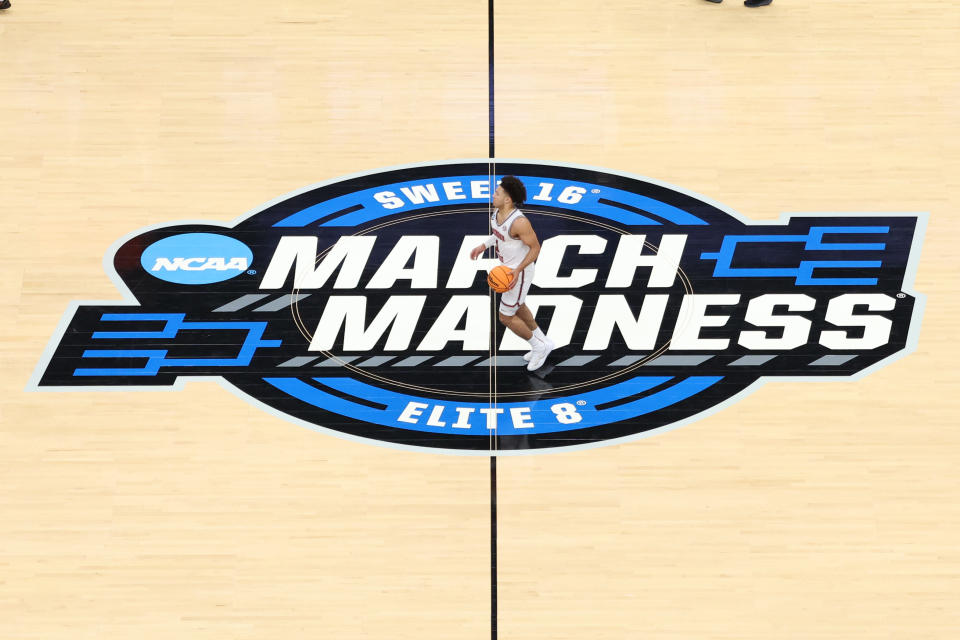NAPLES, Fla. – College basketball moved one step closer this week to an expanded NCAA men’s basketball tournament.
NCAA officials presented Division I conference commissioners on Wednesday with at least two models of an expanded field, one with four additional teams and another with eight additional teams, commissioners told Yahoo Sports. Officials declined to speak publicly about the models.
The models would expand the field from 68 teams to 72 or 76 teams, with additional at-large picks as well as at least one additional First Four site. Any expansion would begin, at the earliest, in the 2025-26 season. If the men’s tournament expands, the women’s tournament will likely see a similar expansion.
Dan Gavitt, vice president of the NCAA men’s basketball championship, unveiled the models in a presentation Wednesday at the commissioners’ annual summer meeting. In the culmination of months of work, Gavitt outlined the possibilities of what commissioners believe is an inevitable expansion of the men’s event – a move championed primarily by power conferences, something Yahoo Sports reported in February.
As a way to avoid eliminating any of the 28 small conference automatic qualifiers, a traditional and popular concept among fans, the NCAA and conference leaders are aiming to add at-large selections as has been done in the past. The last expansion, in 2011, added four at-large teams and created the First Four in Dayton, Ohio, where two pairs of 16 seeds and two pairs of at-large picks face off in play-in games.
Any further expansion of the field is expected to result in at least one additional First Four site, perhaps in a western time zone. But expanding the tournament, even with only four teams, is a complex issue.
Officials plan to maintain the current group of 64 teams. Since the winners of the initial game need a place in that structure, space must be made. More 10-12 seeds, originally in the 64-team pool, could be forced to win play-in matches that Tuesday or Wednesday to advance to the first round on Thursday or Friday.
More difficult decisions also await us. Officials must determine whether more automatic qualifiers from small conferences will be relegated to play-in games, a sensitive issue for some commissioners of lower-income leagues.
There’s something else: will additional games generate more revenue? It remains an unanswered question. CBS and Turner are not required to increase the amount they pay, according to those with knowledge of the contract.
Gavitt’s model of a possible expanded field is one step in an approval process that could take many more months as commissioners explore altering what is widely known as the most popular event in college athletics and American sports. Several groups are scheduled to examine the expansion model this summer and fall, including meetings of the NCAA basketball oversight committee next week and an NCAA basketball selection committee meeting scheduled for next month.
The basketball tournament is the NCAA’s largest and most vital source of revenue, keeping the organization afloat and helping to subsidize hundreds of small college athletic departments. As part of a tournament television deal with CBS and Turner that runs through 2032, the NCAA annually distributes about $700 million to its schools, both in base amounts and in units earned by advancing the event.
While much of that revenue goes to power conferences, leaders from the Big Ten, SEC, ACC and Big 12 have publicly expressed their desire to expand the field of 36 overall picks to clear a path for more schools. This spring, commissioners held multiple meetings with NCAA President Charlie Baker about expanding the tournament, strongly encouraging the NCAA to find a way to grow the field.
“I want to see the best teams competing for a national championship, no different than what (the Big Ten and SEC) want to see in football,” Big 12 commissioner Brett Yormark told Yahoo Sports in February. “I’m not sure that’s happening currently.”
ACC Commissioner Jim Phillips believes a “holistic review” of the tournament is necessary, and SEC Commissioner Greg Sankey has suggested an expansion of the field several times over the past two years.
The expansion is nothing new for the event. In 1975, the tournament was expanded to include 32 teams to allow a second team to represent a conference in addition to its champion. In 1979, it grew to 40 teams and then to 48 in 1980. In 1985, the tournament moved to 64 teams, and in 2001, the tournament expanded to a single team to create a play-in game before the 2011 expansion to 68. .


